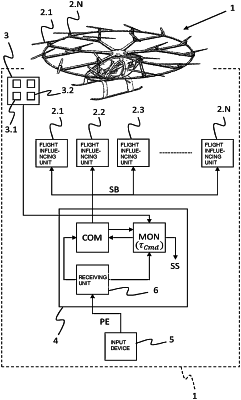| CPC B64C 13/503 (2013.01) [G05D 1/102 (2013.01); G06F 17/11 (2013.01)] | 15 Claims |

|
1. A method for controlling an aircraft (1), by which flight influencing units (2.1, . . . , 2.N) of the aircraft (1) are controlled, the method comprising:
a) supplying the flight influencing units with control commands (SB) via a first channel from a first computer (COM), the control commands (SB) originate from or are derived from a pilot input (PE),
b) monitoring the control commands (SB) by a second channel and a second computer (MON), the second computer (MON) checking whether the control commands (SB) are suitable for a given physical state of the aircraft (1) and the pilot input (PE),
c) determining by the second computer (MON) whether a current navigation state of the aircraft (1) coincides with the pilot input (PE), the pilot input (PE) having been transformed into a desired navigation state of the aircraft (1) within a prescribed deviation, and checking, by a reverse control assignment, whether the control commands (SB) during an activation of the flight influencing units (2.1, . . . , 2.N) of the aircraft (1) lead to a first force/moment vector τCmd for the aircraft (1) which is suitable for the given physical state of the aircraft (1), by at least one of:
i) comparing the first force/moment vector, derived from the control commands (SB), with a second force/moment vector τMON, said second force/moment vector being determined independently of the first force/moment vector,
ii) checking for the first force/moment vector whether at least one of an axis or an amount of a torque contained in the first force/moment vector lies within a prescribed tolerance interval, or
iii) checking for the first force/moment vector whether the first force/moment vector coincides with the pilot input (PE) within the prescribed deviation; and,
d) generating a control signal or an adapted control signal for controlling the aircraft (1) in dependence on a determination result of the determining in step c) and a checking result of steps i) to iii).
|